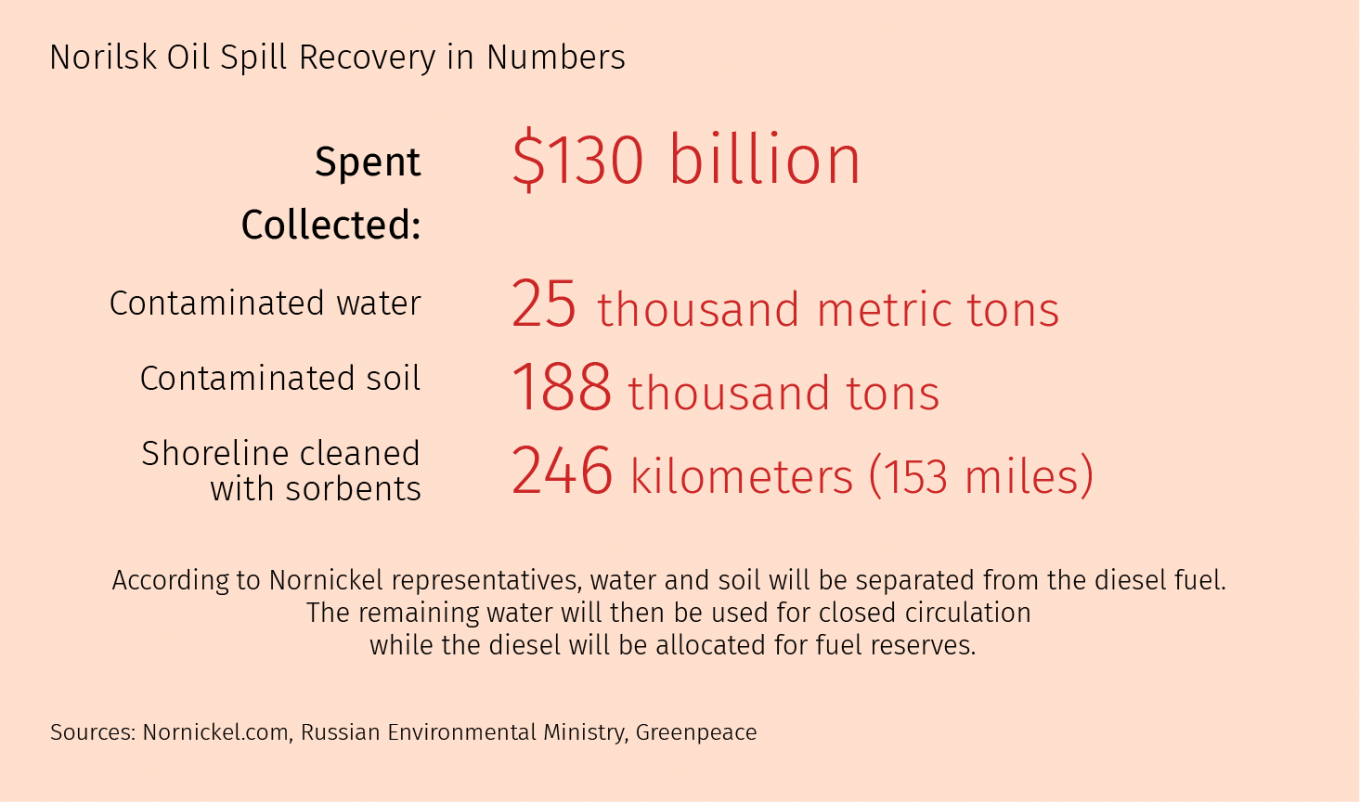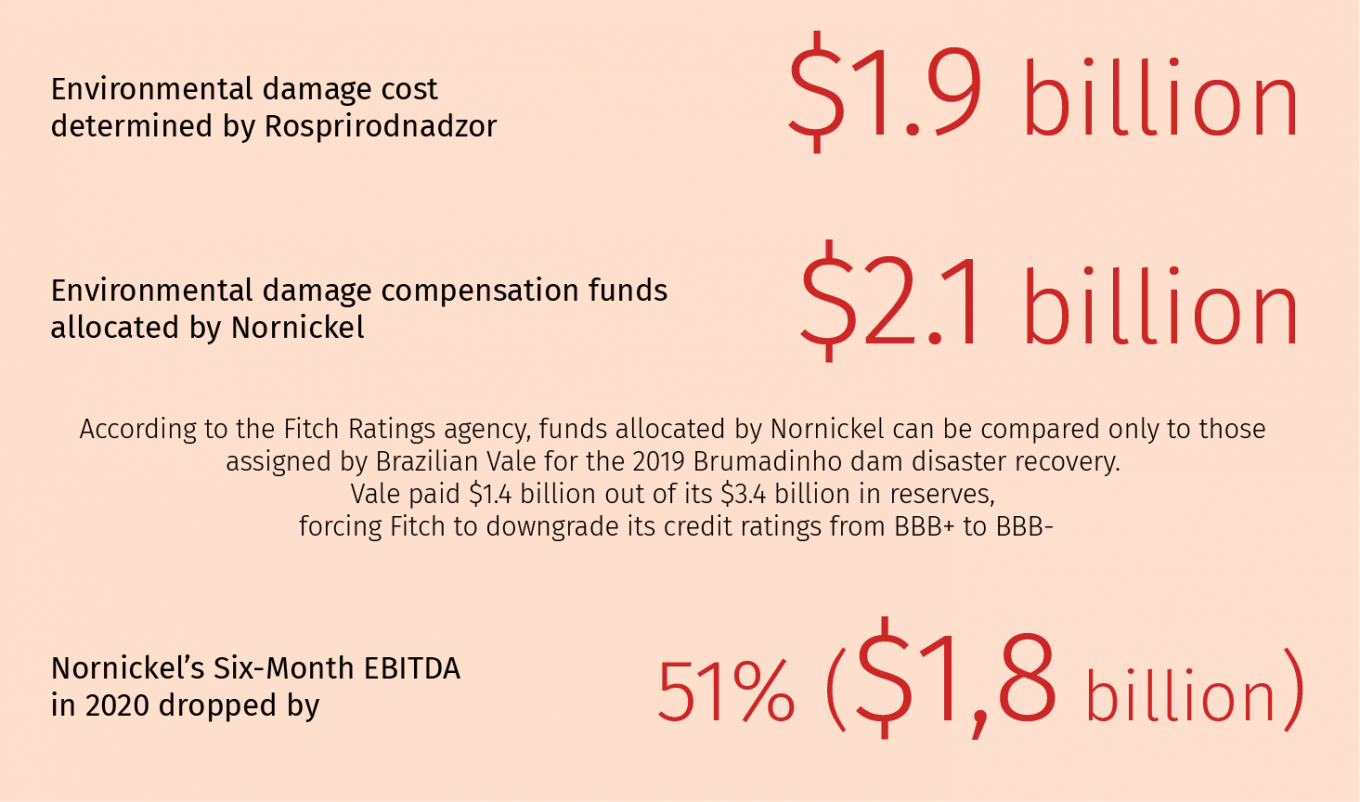Ecologists often joke that Europe owes its clean skies to the dirty sky of Norilsk — and there’s more than a shred of truth in this assertion. The Nornickel mining and metallurgical company supplies metals to 37 countries, where they are used in the production of electric cars, electricity stations and solar panels. But in the process of extracting all these environmentally valuable metals, Nornickel systemically pollutes the surrounding nature with sulfur dioxide (SO2). Toxic in high doses, this gas causes choking, coughing, pulmonary edema, and (according to the WHO) increases the frequency of respiratory tract diseases.
Sulfur dioxide makes up 98% of all the company’s emissions (according to data from Nornickel itself). It is formed during the processing of sulfide ores, in which metals are combined with sulfur. According to Igor Shkradyuk, coordinator of the environmental industry program at the Center for the Protection of Wild Nature, it is difficult to understand from the mining company’s reports what precise proportion is currently recovered, but more than 80% of sulfur dioxide definitely escapes into the atmosphere.
Emissions amount to around 2 million tons per year — that is, more than half of all sulfur dioxide emissions in Russia (3.6 million tons in 2018, according to a state report by the Ministry of Natural Resources), or twice the total amount of emissions from the United States, (according to 2018 data from Greenpeace).The factories in Norilsk are the world’s largest stationary source of man-made sulfur dioxide, according to Greenpeace data.
These represent only the systemic pollution we know about, but there are also accidents and violations which are not reflected in the statistics. A good example of this is an unscheduled check carried out by Russian environmental watchdog Rosprirodnadzor after the spill of 21,000 tons of diesel fuel from a tank owned by the Norilsk-Taimyr Energy Company (NTEK) in May 2020, which was the largest man-made disaster in the Arctic to date.
Counting on Musk
According to forecasts by McKinsey & Co., demand for high-quality Class 1 nickel — precisely the type produced by Nornickel – is set to grow. By 2030 it will rise from the current 2.2 million tons to 3.5–4 million tons, primarily due to the growth of electric car production. The question is, what will be the cost of this growth to the environment?

The indigenous peoples of northern Russia have asked Tesla and SpaceX founder Elon Musk not to buy Nornickel products until independent experts have been able to estimate the total damage inflicted by the company’s activity on the Taimyr Peninsula and the Murmansk Region, but the company itself will not pay out compensation to these indigenous peoples and will not finance remediation. Musk himself, however, has promised a “gigantic long-term contract” to anyone who is able to mine nickel without serious damage to the environment.
Environmentalists have expressed doubts about Nornickel’s choice of technology to reduce its sulfur dioxide emissions: The company has opted for a cheaper solution that requires the mass onsite storage of products resulting from the mining process. Nornickel President Vladimir Potanin has previously questioned the reliability of more advanced technology and pointed to Norilsk’s geography and inaccessibility as meaning that some other options – such as using emissions to create sulfuric acid which can then be sold — are unfeasible.
The clean and the dirty
“Don’t believe them when they try to convince you that it’s technologically impossible to ensure the cleanliness of emissions from nickel production,” a Finnish diplomat told Russian journalists several years ago. This diplomat hailed originally from the town of Harjavalta, where there was also a nickel plant. Under pressure from local residents and the authorities, the firm rolled out a new emissions system in the mid 1990s which captures 99% of all sulfuric emissions from the plant.
As Shkradyuk explains, at that time it was also a full-cycle plant, just like the one in Norilsk. In 2007 Nornickel bought part of this plant. Today, according to a representative of the company, only the final stage of the process — metal refining — now takes place there, so the negative effect on the environment is insignificant.

Building a clean factory is not cheap: half of the cost of construction goes on water and air purification systems, says Shkradyuk. If there are no strict rules obligating a business to spend twice as much money on building a plant, then it simply won’t do this.
Nornickel is an extremely profitable company and invests tens of billions of rubles annually in the protection of the environment — 39.5 billion rubles ($500million) in 2019. This sum could be even larger, were it not for disagreement between shareholders.
“I have always been a supporter of the idea that part of the profits should be allocated not for dividends, but to the Norilsk Nickel investment program. All the more since we have an obligation to carry out many environmental activities,” explained Potanin (his Interros Holding Company owns a 34.6% stake) in an interview with the Komsomolskaya Pravda tabloid in April.
Potanin also suggested postponing the payment of dividends in 2020, so as not to anger people in a crisis and create a reserve fund. However, the suggestion did not find support from the second largest shareholder, UC Rusal (27.8%), previously controlled by the industrialist Oleg Deripaska. The company needs dividends from Nornickel in order to service its own debt. UC Rusal had net profits of $960 million in 2019, and a net debt of $6.5 billion, with interest payments on the debt making up $553 million. After the fuel spill, Potanin repeated his suggestion, but once again it did not find support. As a result, in the first six months of 2020 Nornickel paid out interim dividends for nine months of 2019 ($1.6 billion), as well as final dividends for 2019 ($1.3 billion).
How much will Nornickel spend on the catastrophe?
Rosprirodnadzor estimated the total damage caused by the recent disaster at 148 billion rubles ($1.9 billion) and filed a lawsuit. Nornickel described the move as premature, but earmarked $2.1 billion for the clean-up and damage compensation.
Swiftly adopted amendments to the Tax Code mean the compensation will go into the federal budget. As economist Natalya Zubarevich noted during a discussion organized by the WWF, this is an extremely cynical move, since the clean-up has not yet been completed, but the money has ended up in a completely different place. At the same time, the main source of revenue for the budget of the Krasnoyarsk Territory — corporate income tax — fell by 22% in the first half of 2020 in comparison with the same period in the previous year.
There is a need to revive “flagged” environmental payments, so that compensation for damages does not become a means of replenishing the budget in difficult economic times, but is directed instead toward the recovery of ecosystems, environmental modernization and technological upgrades in the company — the source of the negative activity, according to ecologist Yevgeny Shvarts who has been working as independent director at Norilsk Nickel since 2019.
Nornickel Senior Ecology Vice President Andrei Bugrov told VTimes that he has already flown twice to Norilsk, and is cooperating with experts, officials, industry and public organizations. But one appointment will not solve the problem, said Bugrov. A total of 10 billion rubles ($130 million) has already been spent on cleaning up after the disaster, with another 13 billion to be allocated in 2021, says Bugrov.
Recovery of the remaining pollutants will continue throughout 2021 and 2022, as the draft of the liquidation plan makes clear. The plan covers only issues for the monitoring and remediation of oil spills, but Greenpeace experts say this is insufficient.
“If we’re going to save the water bodies that have suffered, then [they need to be protected] from other sources of pollution too,” said Greenpeace’s program and expertise director Ivan Blokov during a discussion in the civic chamber, a government-organized forum for Russian NGOs to give feedback on laws and regulations. “What is important are changes on a systemic level,” he said. One federal official has expressed concern that the company responsible for the post-accident clean-up is NTEK, which is directly to blame for the leak: will its actions be subject to the proper oversight?
In the Arctic, recovering spilled fuel is particularly challenging, says Georgy Safonov, director of the Center of Environmental Economics and Natural Resources at Moscow’s Higher School of Economics. The negative impact of hydrocarbons on the fragile ecosystem of the Arctic is extremely dangerous and will be felt for a very long time. While in the Gulf of Mexico hydrocarbon-absorbing bacteria can be used, in the cold climate of the Arctic these simply do not exist, he explains.
Not only will these systemic problems not be solved in a year, but the external challenges will increase. One of these is the melting of the permafrost. When in the mid-20th century industrial plants began to be constructed in the Arctic zone, few could have imagined that the average annual temperature would increase so quickly, says Safonov. All of those factories, gas and oil pipelines, roads and power lines did not take the melting of the permafrost into account.
There is no doubt, he warns, that catastrophes like those in Norilsk will occur with increasing frequency in the near future as a result of warming, unless all companies working in the Arctic take rapid steps to modernize with climatic factors in mind.
This article was originally published in Russian by our partner outlet VTimes
